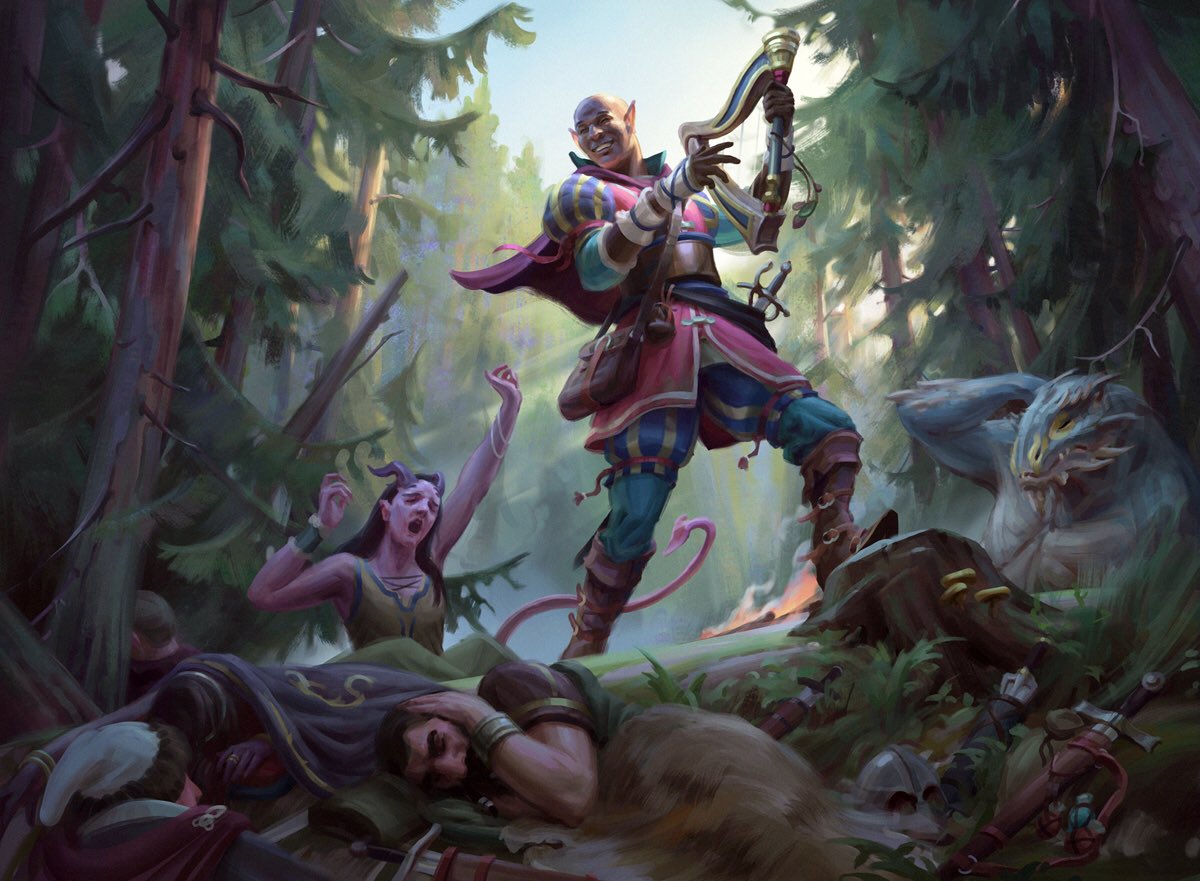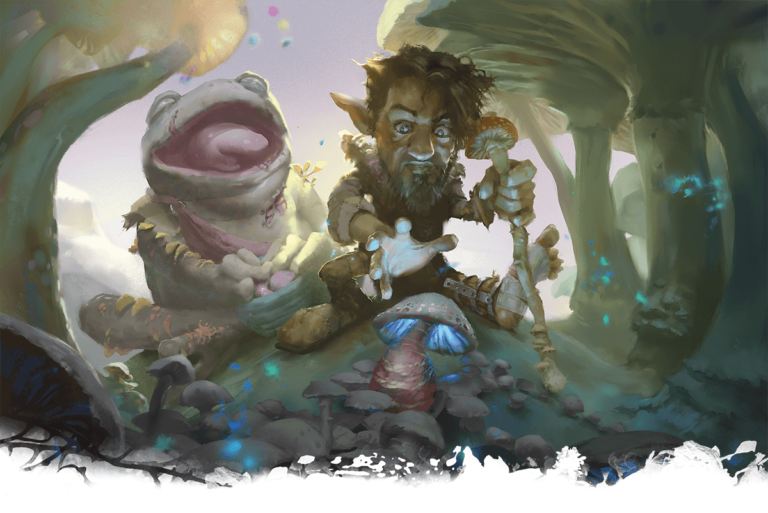Mastering Melody: A Player’s Guide to 5e Instruments
Discover the power of 5e instruments in D&D, from luting to fluting, and their impact on your bard’s journey. This guide clarifies each instrument’s role and why choice matters for gameplay and character development. Get ready to fine-tune your character’s presence with the perfect musical companion.

Key Takeaways
- Bards in D&D 5e have a wide selection of instruments that define their character’s journey and persona, with different instruments offering unique roleplaying opportunities and reflecting on the character’s identity.
- The Instruments of the Bards are specialized magical items that can store and cast spells, enhancing a bard’s abilities, while non-bards risk danger when trying to use them due to item attunement requirements.
- Instruments in D&D 5e do more than play music; they can serve as tools for strategic advantages, arcane foci for spellcasting, and are integral in world-building, enriching the campaign with culture, atmosphere, and lore.
A Bard’s Arsenal: Overview of 5e Instruments
In the world of D&D 5e, the bard class has a unique relationship with music. The bard’s arsenal is vast, offering a plethora of musical instruments for use in gameplay. From the ten instruments listed in the Player’s Handbook:
- Bagpipes
- Drums
- Dulcimer
- Flutes
- Lute
- Lyre
- Horn
- Pan flute
- Shawm
- Viol
Each instrument, categorized into woodwind, percussion, string, and brass instruments, brings a unique sound and provides distinct roleplaying opportunities. Among these, the reeded woodwind instrument consisting of various types adds a special touch to the ensemble.
The choice of instrument can significantly define a character’s journey and persona. For instance, a bard carrying a horn instrument might create a different impression than one strumming a lute, even though they are both skilled musicians. The horn, a simple wind instrument, might be seen as a symbol of raw, natural talent, while the lute, a plucked string instrument, could be associated with refined sophistication. The choice of instrument is more than just a gameplay decision; it’s a reflection of the character’s identity.
Wind Instruments: The Breath of Adventure

Journeying into the world of wind instruments in D&D 5e is like embarking on an adventure filled with diverse sounds and characters. From the pan flute to the shawm, the selection of wind instruments is as varied as the landscapes in the game. The pan flute, composed of multiple wooden tubes of varying lengths, can produce a range of notes when blown across, offering a simple yet captivating sound. The shawm, a woodwind instrument resembling a large wooden recorder, offers varying pitches based on size and adds depth to the sonic landscape.
Wind instruments also include:
- traditional signaling horns
- more intricate ones like the Songhorn and Longhorn
- the horn, with its simplicity and singular note capability, often referred to as a simple wind instrument cut
- the bagpipes, which replicate their historical counterparts in the game
- the hulusi, a distinctive instrument combining bamboo pipes and a gourd
These instruments contribute to the thematic richness of a fantasy setting and can enrich your campaign’s musical backdrop.
Stringed Harmonies: From Lyres to Lutes
The realm of stringed instruments in D&D 5e is a symphony of sounds, each instrument carrying its own unique melody and story. Some examples include:
- The lyre: a handheld string instrument that stands out for its convenient size and ease of play.
- The harp: a large, upright instrument, its sonorous plucked strings creating a captivating sound.
- The yarting: similar to a guitar, it allows for a diverse range of expression.
- The viol: a multi-faceted instrument playable by both plucking or using a bow.
These instruments offer players a variety of options to produce notes for musical expression in the game.
Stringed instruments also offer practical advantages for traveling musicians. Some examples include:
- The medieval harp, smaller and more portable than many of its stringed counterparts, provides on-the-go bards with melodic charm without the encumbrance.
- The lyre, with its handheld size, offers practicality despite its somewhat awkward shape during combat.
- Acoustic guitars and mountain dulcimers, which are also portable and versatile.
These stringed instrument performers, along with others, contribute to a rich musical landscape with their varied sounds and playing styles.
Rhythms of Battle: Percussion Instruments
Percussion instruments in D&D 5e are the heartbeat of the game’s musical landscape. They come in a variety of forms, each adding a unique sound to enhance the musical experience. Some examples include:
- The drum, which can be carried via a strap and tuned for different atmospheres
- The tantan, similar to a tambourine, adding a rhythmic jingle
- The hand drum, offering portable, hand-played rhythms, enabling musicians to carry the beat wherever they go.
The resonance of percussion instruments like the wargong and the melodic tinkling of tockens contribute significantly to the setting’s atmosphere. Tambourines, characterized by jingling discs around a flat drum, exemplify how percussion can enhance the tempo and dynamics of songs within the gameplay, making every battle or celebration an immersive musical experience with the drum’s bass sound.
Enchanted Melodies: Magical Musical Items
Music in D&D 5e is not just about creating melodies; it’s also about casting spells. The Instruments of the Bards are specialized magical masterwork musical items, primarily used by bards to cast spells and amplify their charmed abilities. They are able to use these instruments as a spellcasting focus.
Crafting Your Sound: Instrument Customization
In D&D 5e, customizing your musical instrument allows you to create a unique sound and look that reflects your character’s personality and journey. While these details do not impact the mechanics of the game, some ways to customize your instrument include:
- Adding gold or silver inlays
- Adjusting the instrument’s build for a distinct tone
- Adorning it with precious stones or intricate carvings to signify your character’s achievements
Crafting a signature instrument is not a task to be taken lightly. It involves collaborating with a skilled craftsman in the game, requiring time, money, and materials to achieve the desired customization. But the outcome – a unique instrument that resonates with your character’s story – makes it all worth it.
See Also: Ranking the Bardic Colleges in 5E
The Musician’s Toolkit: Instrument Price and Weight
Choosing a musical instrument in D&D 5e is not just about the sound. It’s about balancing affordability and portability to find the perfect instrument for your character. The flute, horn, and drum are some of the most economical instruments in the game, while the bagpipes, dulcimer, and viol are priced higher, with the lute being the most expensive. For those interested in DND brass instruments, affordability and portability should also be considered.
Weight is another critical factor to consider. Lighter instruments, like the flute, viol, and lute, are convenient for adventurers to carry, often having a lower weight lb. Heavier instruments, like the bagpipes and the dulcimer, may be less convenient for characters who need to travel light. Therefore, players must balance the cost against the weight and the sound they prefer to find the right instrument for their characters.
| Instrument | Cost | Weight |
| Bagpipes | 30 gp | 6 lb. |
| Drum | 6 gp | 3 lb. |
| Dulcimer | 25 gp | 10 lb. |
| Flute | 2 gp | 1 lb. |
| Lute | 35 gp | 2 lb. |
| Lyre | 30 gp | 2 lb. |
| Horn | 3 gp | 2 lb. |
| Pan flute | 12 gp | 2 lb. |
| Shawm | 2 gp | 1 lb. |
| Viol | 30 gp | 1 lb. |
Gaining Proficiency with Instruments
In D&D 5e, proficiency with a musical instrument is not just about playing music; it’s about enhancing your character’s abilities during performance checks. Characters can obtain proficiency with musical instruments through:
- their choice of race
- their class
- their background selection
- picking certain feats.
Having proficiency lets a character add their proficiency bonus to any ability checks involving the use of that instrument, amplifying their skillset. However, proficiency in one type of musical instrument does not confer proficiency in another.
Worldbuilding with Music: Instruments in Your Campaign
Music is a universal language, and in D&D, it permeates all cultures, continents, and planes of existence. By incorporating music and instruments into your D&D campaign, you can enrich the world’s history, create a unique atmosphere, and provide unique abilities for players.
Songs often hold keys to understanding myths, legends, and crucial information like prophecies, traps, and monsters’ weaknesses. Legendary instruments created by iconic figures in the lore can be used to enrich the world’s history and provide unique abilities to those who wield them.
Music and instruments can be powerful tools in crafting an immersive, dynamic, and memorable campaign, as they create sounds that captivate the audience. It’s worth mentioning that I never expect my players with bard characters to try to sing or perform. While some people love that aspect of D&D, many just aren’t comfortable doing it. It’s never a good idea to push people into something like that when they aren’t comfortable with it.
Frequently Asked Questions
What are the different types of musical instruments in D&D 5e?
In D&D 5e, the musical instruments are divided into woodwind, percussion, string, and brass types, each providing distinct sounds and roleplaying potential. Of course in the world of magic, there are no limits to what you add to your game.
How can I customize my instrument in D&D 5e?
You can customize your instrument in D&D 5e by adding gold or silver inlays, adjusting the build for a distinct tone, or adorning it with precious stones or intricate carvings, allowing you to personalize it to your liking.
What factors should I consider when choosing a musical instrument in D&D 5e?
Consider the cost, weight, and sound of the musical instrument to enhance your adventure and role-playing experience in D&D 5e. These factors can greatly impact your gameplay. From an aesthetic standpoint, I would pick the instrument that makes the most sense for your character’s background.
Can musical instruments be used for purposes other than music in D&D 5e?
Yes, in D&D 5e, musical instruments can be used for signaling in battles and as arcane foci for spellcasting, among other purposes. They could also be used as improvised weapons.
How can I incorporate music and instruments into my D&D campaign?
Incorporate music and instruments into your D&D campaign by using them to enrich the world’s history, create a unique atmosphere, signify cultural practices, and provide unique abilities for players. Feel free to encourage people to play regardless of their actual ability level. This will add depth and immersion to your game.
Summary
Music and instruments in D&D 5e play a pivotal role, transforming the gaming experience from ordinary to extraordinary. From offering a variety of musical instruments to exploring their unconventional uses in battles and signaling, to understanding the concept of proficiency and the use of instruments as arcane foci, we have lots of uses for non-magical music in tabletop gaming.
Looking for more D&D content? Be sure to check out our starting gold 5E Guide!






